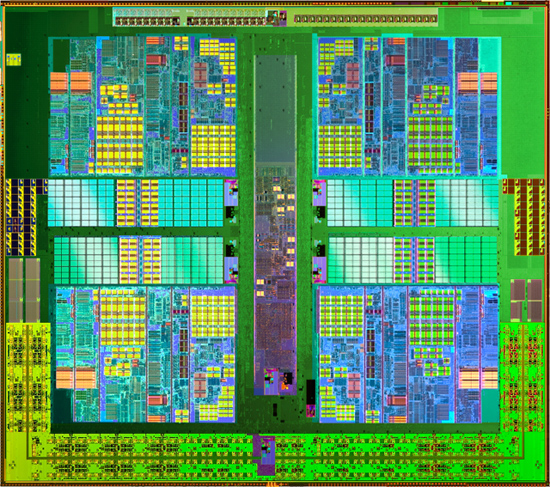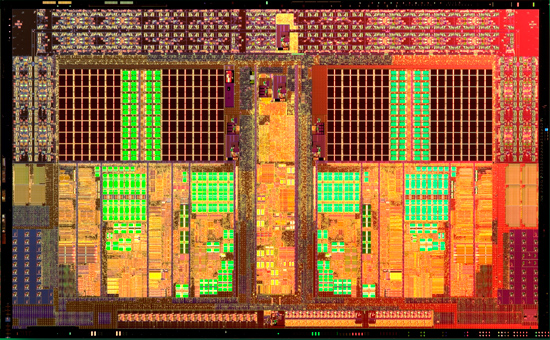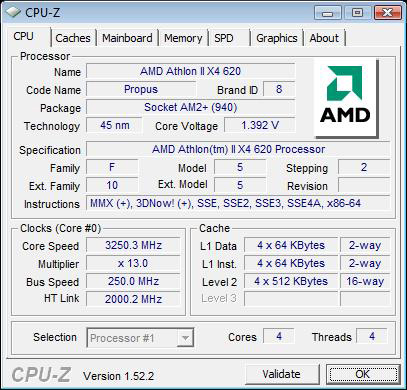AMD Athlon II X4 620 & 630: The First $99 Quad Core CPU
by Anand Lal Shimpi on September 16, 2009 12:00 AM EST- Posted in
- CPUs
How does AMD respond to Lynnfield? Is it by drastically cutting prices on Phenom II? Nope. By introducing the world’s first quad-core processor to debut at $99. Now that’s cool.

It’s called the Athlon II X4 and its existence shouldn’t be any surprise. AMD quietly announced it along with the Athlon II X2 line.

Today we get two models: the Athlon II X4 630 and the Athlon II X4 620, priced at $122 and $99 respectively. The only difference between the two is clock speed; the 630 runs at 2.8GHz while the 620 runs at 2.6GHz. These are both AM3 chips meaning they'll work in AM3 motherboards with DDR3 memory or AM2+ boards with DDR2 memory.
| Processor | Clock Speed | L2 Cache | L3 Cache | TDP | Price |
| AMD Phenom II X4 965 BE | 3.4GHz | 2MB | 6MB | 140W | $245 |
| AMD Phenom II X4 955 BE | 3.2GHz | 2MB | 6MB | 125W | $245 |
| AMD Phenom II X4 945 | 3.0GHz | 2MB | 6MB | 125W | $225 |
| AMD Phenom II X3 720 BE | 2.8GHz | 1.5MB | 6MB | 95W | $145 |
| AMD Phenom II X2 550 BE | 3.1GHz | 1MB | 6MB | 80W | $105 |
| AMD Athlon II X4 630 | 2.8GHz | 2MB | 0MB | 95W | $122 |
| AMD Athlon II X4 620 | 2.6GHz | 2MB | 0MB | 95W | $99 |
| AMD Athlon II X2 250 | 3.0GHz | 2MB | 0MB | 65W | $87 |

This isn’t a harvested Phenom II nor is it a pair of Athlon II X2s, instead it looks like we have a brand new die on our hands (some Athlon II X4s will be crippled Phenom IIs but AMD insists that the new die will be used). The Athlon II X4 has four cores on a single die, but unlike the Athlon II X2 each core only has a 512KB L2 per core. You can tell by the die shot that the core-to-cache ratio is much higher than on the X2:

The 45nm Athlon II X4 Propus die

The 45nm Athlon II X2 die (note the larger L2 per core)
Like the rest of the Athlon II lineup there is no L3 cache. This helps keep the die small (and affordable) but also hurts performance:
| Processor | SYSMark 2007 Overall | E-Learning | Video Creation | Productivity | 3D |
| AMD Phenom II X4 920 (2.8GHz) | 173 | 151 | 212 | 167 | 167 |
| AMD Athlon II X4 630 (2.8GHz) | 157 | 128 | 221 | 131 | 162 |
| % of Phenom II X4 | 91% | 85% | 104% | 78% | 97% |
At the same clock speed the Athlon II X4 should offer roughly 90% of the performance of a Phenom II X4.
| Processor | Cores | Manufacturing Process | L1 Cache | L2 Cache | L3 Cache | Die Size | Transistor Count |
| AMD Phenom II X4 | 4 | 45nm | 128KB per core | 512KB per core | 6MB | 258 mm2 | 758M |
| AMD Athlon II X4 | 4 | 45nm | 128KB per core | 512KB per core | 0MB | 169 mm2 | 300M |
| AMD Athlon II X2 | 2 | 45nm | 128KB per core | 1MB per core | 0MB | 117 mm2 | 234M |
| Intel Core 2 Quad Q8xxx | 4 | 45nm | 64KB per core | 4MB | 0MB | 164 mm2 | 456M |
The price is unbeatable. If we ignore the 630 for a moment, the Athlon II X4 620 is by far the cheapest route to four cores on the market. Intel’s most affordable quad-core is the Core 2 Quad Q8200 at $163, while AMD would previously charge you $163 for a Phenom X4 9600B. This is where the AM3/AM2+ compatibility play really helps out. Motherboard/memory costs are as cheap as possible thanks to AMD's incredible socket flexibility.

And just in case you’re wondering, yes, the Athlon II X4 620 actually delivers performance competitive with the Q8200 but for 60% of the cost. It’s not all that clear cut, there are some cases where the 620 is faster but others where the Q8200 is much faster. On average it ends up being a wash but you’ll want to pay attention to the coming pages to see how the cookie crumbles as it does vary from test to test.

Codename Propus
Overclocking isn't unfortunately as good as the Phenom IIs; the result of a conscious design decision or simply the early nature of the Propus die. That being said, without a single extra millivolt I was able to hit 3.25GHz on my Athlon II X4 620 sample - making it even more valuable. Extra voltage proved mostly useless, I could only approach 3.4GHz with an extra 300mV.
Let’s see, have I thoroughly ruined the surprise? Check. Now let’s get to the tests.
The Test
| Motherboard: | Intel DX58SO (Intel X58) Intel DX48BT2 (Intel X48) Gigabyte GA-MA790FX-UD5P (AMD 790FX) |
| Chipset: | Intel X48 Intel X58 AMD 790FX |
| Chipset Drivers: | Intel 9.1.1.1015 (Intel) AMD Catalyst 8.12 |
| Hard Disk: | Intel X25-M SSD (80GB) |
| Memory: | Qimonda DDR3-1066 4 x 1GB (7-7-7-20) Corsair DDR3-1333 4 x 1GB (7-7-7-20) Patriot Viper DDR3-1333 2 x 2GB (7-7-7-20) |
| Video Card: | eVGA GeForce GTX 280 |
| Video Drivers: | NVIDIA ForceWare 180.43 (Vista64) NVIDIA ForceWare 178.24 (Vista32) |
| Desktop Resolution: | 1920 x 1200 |
| OS: | Windows Vista Ultimate 32-bit (for SYSMark) Windows Vista Ultimate 64-bit |










150 Comments
View All Comments
the zorro - Thursday, September 17, 2009 - link
the turbo overclocking is plain overclocking of all lynnfield cores at least 600 mhz and you are comparing lynfield overcloded results versus phenom 2 955 stock speeds.phenom 2 is much better than lynnfied 750 and when overclocked to 4ghz remains at 55 C while lynnfield temps are almost 100C. which sucks.
all the 'advantage' of lynnfied in these results comes from benchmarking an overclocked processor and present it as if it were stock speed, which is illegal
silverblue - Thursday, September 17, 2009 - link
Wrong. I'll help you here...i5 750
Default: 2.66GHz
4 cores: 2.93GHz 3 cores: 2.93GHz 2 cores: 3.06GHz 1 core: 3.20GHz (gains: 266MHz/266MHz/400MHz/533MHz)
i7 860
Default: 2.80GHz
4 cores: 3.06GHz 3 cores: 3.06GHz 2 cores: 3.33GHz 1 core: 3.46GHz (gains: 266MHz/266MHz/533MHz/667MHz)
(all data reassembled from the second table at http://www.anandtech.com/cpuchipsets/showdoc.aspx?...">http://www.anandtech.com/cpuchipsets/showdoc.aspx?...
The turbo mode gives a minimum boost of 266MHz and a maximum of either 533MHz for the i5 or 667MHz for the i7. NOT 600MHz for all cores. Quite where you got that from is beyond me. Additionally, Turbo is a 100% legitimate technology. Would you be happier if the default clock was throttled?
As for illegal... we have a word in the UK for this sort of comments, and it's "bollocks".
Eeqmcsq - Thursday, September 17, 2009 - link
Good chart, though you linked to the wrong page. It was on the Turbo Mode page. I have no idea how I missed that chart the first time I read the article.But for the i5 750, if the lowest GHz Turbo mode will operate at is 2.93 GHz, why doesn't Intel just call it an i5 750 at 2.93 GHz, instead of 2.66 GHz?
silverblue - Thursday, September 17, 2009 - link
My bad - the link has a ) after it which sends you to the intro page. I should've put a space after the link.At least you checked through to find it... I doubt "the zorro" has bothered as of yet.
You make a very good point about Turbo but it's not as if Intel is pretending it doesn't exist or it's disabled; it should be relatively easy for people to make comparisons using the benchmarks in this article as well as others. I suppose it may have helped if there was data suggesting the clock speed at the time of a specific test, but I can't imagine that'd be a very easy thing to do especially if threads are being bounced across cores and as a result, the clock speed is constantly fluctuating. The alternative would've been to disable Turbo and that would've prevented people like "the zorro" from his pointless tirade on here, but they would've been disabling a feature of the processor to test it against rivals that lack that feature.
Eeqmcsq - Thursday, September 17, 2009 - link
> I suppose it may have helped if there was data suggesting the clock speed at the time of a specific test, but I can't imagine that'd be a very easy thing to do especially if threads are being bounced across cores and as a result, the clock speed is constantly fluctuating.- No, but the troll does make one point that I agree with. When an i5 is run with Turbo mode, Anand's charts should NOT list that it is at 2.66 GHz. He should list it as 2.93-3.20 GHz, especially if it is 100% certain that Turbo mode NEVER reaches the baseline Turbo off clock of 2.66 GHz.
> The alternative would've been to disable Turbo and that would've prevented people like "the zorro" from his pointless tirade on here, but they would've been disabling a feature of the processor to test it against rivals that lack that feature.
- Well, I've asked for the same thing, but for different reasons that I don't want to repeat in this comment or I'll sound like a troll. :)
the zorro - Thursday, September 17, 2009 - link
if you are an accountant and do the same thing and try to present false results as real then you would go to jail.you can call a bank robbery an 'auto loan' but still is robbery and you still go to jail.
people is not stupid.
silverblue - Thursday, September 17, 2009 - link
AMD, please just incorporate a turbo mode into your next CPUs so we can get rid of trolls like this one. Do it for me.Please.
the zorro - Thursday, September 17, 2009 - link
no amd wont do that.why?
because a platform at stock speed is more stable than other that is auto overclocking, also intel created the turbo crap story to charge for the overclocking.
yes intel is charging their users for the overclocking,now overclocking is a feature and intel charges for it.
amd phenom 2 overclocking is free.
try to auto overclock a server, that is not good and creates instability in the platform.
silverblue - Thursday, September 17, 2009 - link
And if they do, oh what will you do then?Additionally, try to explain to me what the 965 BE is other than an overclocked variant of the 955, which in turn was an overclocked variant of the 945. Isn't it interesting how none of these overclocks better than the others, and why the 965 BE has a higher TDP than the 955?
You act as if AMD and Intel have never produced an overclocked variant of any of their CPUs until Nehalem turned up.
the zorro - Thursday, September 17, 2009 - link
i can see that you have no clue, when a new processor is introduced that is 200 mhz faster than another model, is not an overclocked processor, is a more refined silicon, with better electrical properties and more stable at highers speeds. and also with higher overclocking headroom.